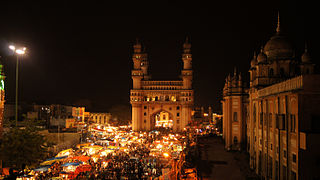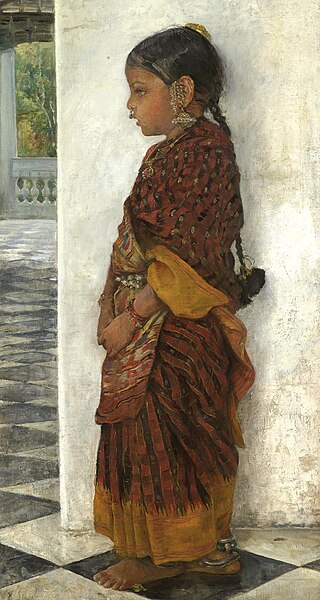Related Research Articles

Andhra Pradesh is a state in the southern coastal region of India. It is the seventh-largest state with an area of 162,970 km2 (62,920 sq mi) and the tenth-most populous state with 49,577,103 inhabitants. It has shared borders with Telangana, Chhattisgarh, Odisha, Tamil Nadu, Karnataka, and the Bay of Bengal. It has the second-longest coastline in India at about 974 km (605 mi). After existence as Andhra State and unified Andhra Pradesh, the state took its present form on 2 June 2014, when the new state of Telangana was formed through bifurcation. Amaravati serves as the capital of the state, with the largest city being Visakhapatnam. Water sharing disputes and asset division with Telangana are not yet resolved. Telugu, one of the classical languages of India used by the majority of people, is the first official language.

Hyderabad is the capital and largest city of the Indian state of Telangana. It occupies 650 km2 (250 sq mi) on the Deccan Plateau along the banks of the Musi River, in the northern part of Southern India. With an average altitude of 542 m (1,778 ft), much of Hyderabad is situated on hilly terrain around artificial lakes, including the Hussain Sagar lake, predating the city's founding, in the north of the city centre. According to the 2011 Census of India, Hyderabad is the fourth-most populous city in India with a population of 6.9 million residents within the city limits, and has a population of 9.7 million residents in the metropolitan region, making it the sixth-most populous metropolitan area in India. With an output of US$74 billion, Hyderabad has the fifth-largest urban economy in India.

Coastal Andhra or Kostandhra is a geographic region in the Indian state of Andhra Pradesh. Vijayawada is the largest city in this region. Region share borders with Uttarandhra, Rayalaseema and Telangana. It was part of Madras State before 1953 and Andhra State from 1953 to 1956. According to the 2011 census, it has an area of 91,915 square kilometres (35,489 sq mi) which is 57.99% of the total state area and a population of 34,193,868 which is 69.20% of Andhra Pradesh state population. This area includes the coastal districts of Andhra Pradesh on the Circar Coast between the Eastern Ghats and the Bay of Bengal, from the northern border with Odisha to Rayalaseema in the south.

Telangana is a landlocked state in India situated on the south-central stretch of the Indian peninsula on the high Deccan Plateau. It is the eleventh-largest state and the twelfth-most populated state in India as per 2011 census. On 2 June 2014, the area was separated from the northwestern part of Andhra Pradesh as the newly formed state of Telangana, with Hyderabad as its capital.

Rayalaseema is a geographic region in the Indian state of Andhra Pradesh. It comprises four southern districts of the State prior to districts reorganisation in 2022 namely Kurnool, Anantapur, YSR and Chittoor districts. Four new districts were created from these namely Sri Sathya Sai Nandyal, Annamayya and Tirupati The As of 2011 census of India, the western four districts of the region had a population of 15,184,908 and covers an area of 71,060 km2 (27,440 sq mi).

The Telangana High Court is the High Court for the Indian state of Telangana. Founded by the 7th Nizam Mir Osman Ali Khan, initially, it was set up as High Court of Hyderabad for the then Princely State of Hyderabad Deccan and later renamed High Court of Andhra Pradesh, as it was set up on 5 November 1956 under the States Reorganisation Act, 1956. The Andhra Pradesh High Court was renamed as High Court of Judicature at Hyderabad in view of the bifurcation of Andhra Pradesh state.

Cheriyal scroll painting is a stylized version of Nakashi art, rich in the local motifs peculiar to the Telangana. They are at present made only in Hyderabad, Telangana, India. The scrolls are painted in a narrative format, much like a film roll or a comic strip, depicting stories from Indian mythology, and intimately tied to the shorter stories from the Puranas and Epics. Earlier, these paintings were prevalent across Andhra, as also various other parts of the country, albeit flavoured with their distinct styles and other local peculiarities dictated by the local customs and traditions. In the same way, Cheriyal scrolls must have been popular across Telangana in earlier times, though with the advent of television, cinemas and computers it has been fenced into its last outpost, the Cheriyal town.

Chirala, is a city in Bapatla district of the Indian state of Andhra Pradesh. It is a municipality and the headquarters of Chirala mandal in Chirala revenue division. As of 2011, it had a population of above 170,000.
Padmasali is a Hindu caste residing in the Indian states of Andhra Pradesh, Telangana, Karnataka, Maharashtra, Gujarat and Tamil Nadu. In coastal Karnataka they called Shettigar. Their traditional occupation is weaving.

Banganapalle mangoes is a mango variety produced in Banganapalle of Nandyal District in the Indian state of Andhra Pradesh. It alone occupies 70% percent of total mango cultivable area of the state and was first introduced by the Farmers of Banaganapalli. It was registered as one of the geographical indication from Andhra Pradesh on 3 May 2017, under horticultural products by Geographical Indication Registry. It is also grown in the other parts of India and Pakistan. The fruit is described as obliquely oval in shape, around 20cm in length, with yellow flesh and a thin, smooth yellow skin. The flesh is of a firm, meaty texture and is sweet and lacks fibre. The cultivar is the most sought after in Andhra Pradesh. It is a very late-season variety that is good for canning. This cultivar is a source of vitamin A & C and is also called king of Mangoes.

Konijeti Rosaiah was an Indian politician who served as the 15th chief minister of United Andhra Pradesh from 2009 to 2010. He also served as the Governor of Tamil Nadu from 2011 to 2016 and the Governor of Karnataka for two months. He was previously an MLC, MLA and MP from the Indian National Congress numerous times and handled many ministerial posts over his long political career spanning over half a century.

Kalamkari is a type of hand-painted cotton textile produced in the Indian state of Andhra Pradesh. Only natural dyes are used in Kalamkari, which involves twenty-three steps.

Pochampally sari or Pochampalli ikat is a saree made in Bhoodan Pochampally, Yadadri Bhuvanagiri district, Telangana State, India. They have traditional geometric patterns in "Paagadu Bandhu" (Ikat) style of dyeing. The intricate geometric designs find their way into sarees and dress materials. The Indian government's official airplane company, Air India, has its cabin crew wear specially designed Pochampally silk sarees.
Venkatagiri Sari is a sari style woven in Venkatagiri of Tirupati district in the Indian state of Andhra Pradesh. It was registered as one of the geographical indication from Andhra Pradesh by Geographical Indications of Goods Act, 1999. Venkatagiri saris are known for their fine weaving. These style of saris can also be found in the villages of Sengunthapuram, Variyankaval, Elaiyur, Kallathur, Andimadam and Marudhur villages.

Gajam Anjaiah, an Indian master handloom designer, who is widely recognised in the handloom industry for his innovations and developments of Tie and Dye handloom products along with Telia Rumal technique of weaving based on Ikat tie-dye process. He received Padma Shri from Government of India under Art category in 2013. He is known for his excellence in traditional handloom design works, such as Puttapaka Sarees in Tie and dye skill, that is the traditional art of designing on paper and then transferring it on to cloth. His dedication to the Handloom Industry has kept the Indian tradition of weaving alive, brought livelihood to the weavers and gave exclusive/unique designed handloom products to the people in India.
Puttapaka Sari is a saree made in Puttapaka village, Samsthan Narayanpuram mandal in Nalgonda district, India. It is known for its unique Puttapaka tie and dye style of sarees.

Pedana Kalamkari also known as Machilipatnam style of Kalamkari work which involves vegetable dyed block-painting of a fabric. it is produced at Pedana a nearby town of Machilipatnam in Krishna district of the Indian state of Andhra Pradesh. It was registered as one of the geographical indication from Andhra Pradesh under handicraft goods by Geographical Indications of Goods Act, 1999.

Telangana State Road Transport Corporation is a state-owned corporation that runs bus transport services to and from the Indian state of Telangana. It was formed in 2014 by splitting the Andhra Pradesh State Road Transport Corporation. Many other Indian metro towns in Andhra Pradesh, Karnataka, Maharashtra, Goa, Odisha and Chhattisgarh are also linked with the services of TSRTC. It serves about 6 million passengers every day, having three zones and services operating through 99 depots.
Gajam Govardhana is an Indian master weaver, known for his work in Ikkat dyeing in the Telia Rumal tradition, and for his handloom creations. In 2011 the government of India honoured him with the fourth-highest civilian award, Padma Shri.

Odisha Ikat, is a kind of ikat known as Bandhakala and Bandha, a resist dyeing technique, originating from Indian state of Odisha. Traditionally known as "Bandhakala"', "Bandha", '"Bandha of Odisha", it is a geographically tagged product of Odisha since 2007. It is made through a process of tie-dying the warp and weft threads to create the design on the loom prior to weaving. It is unlike any other ikat woven in the rest of the country because of its design process, which has been called "poetry on the loom". This design is in vogue only at the western and eastern regions of Odisha; similar designs are produced by community groups called the Bhulia, Kostha Asani, and Patara. The fabric gives a striking curvilinear appearance. Saris made out of this fabric feature bands of brocade in the borders and also at the ends, called anchal or pallu. Its forms are purposefully feathered, giving the edges a "hazy and fragile" appearance. There are different kinds of bandha saris made in Odisha, notably Khandua, Sambalpuri, Pasapali, Kataki and Manibandhi.
References
- ↑ Zachariah, Preeti (26 August 2016). "Telia Rumal: Is the tide turning?". mint. Retrieved 30 June 2021.
- ↑ Sangam, Sowmya (7 June 2020). "'Puttapaka Telia Rumal' gets Geographical Indication tag". Telangana Today . Archived from the original on 4 September 2020. Retrieved 23 July 2020.
- ↑ "'Telia Rumal' saris set for comeback". The Hindu. 1 November 2008. Retrieved 28 June 2019.
- ↑ Thatipalli, Mallik (22 June 2020). "Once Hyderabad aristocracy's favoured weave, how 'Telia Rumal' gained new lease of life". Firstpost. Retrieved 30 June 2021.
- ↑ "'Recognition to weavers'". The Hindu. 26 January 2011.
- ↑ Kandavel, Sangeetha (12 May 2020). "'GI tag for Jharkhand's Sohrai Khovar painting, Telangana's Telia Rumal '". The Hindu.
- ↑ Prabhu, Vidya (19 April 2012). "Open Thread". The Indian Express. Retrieved 28 June 2019.
- ↑ "Always wanting more?". The Hindu . 3 January 2006. Archived from the original on 17 July 2007.